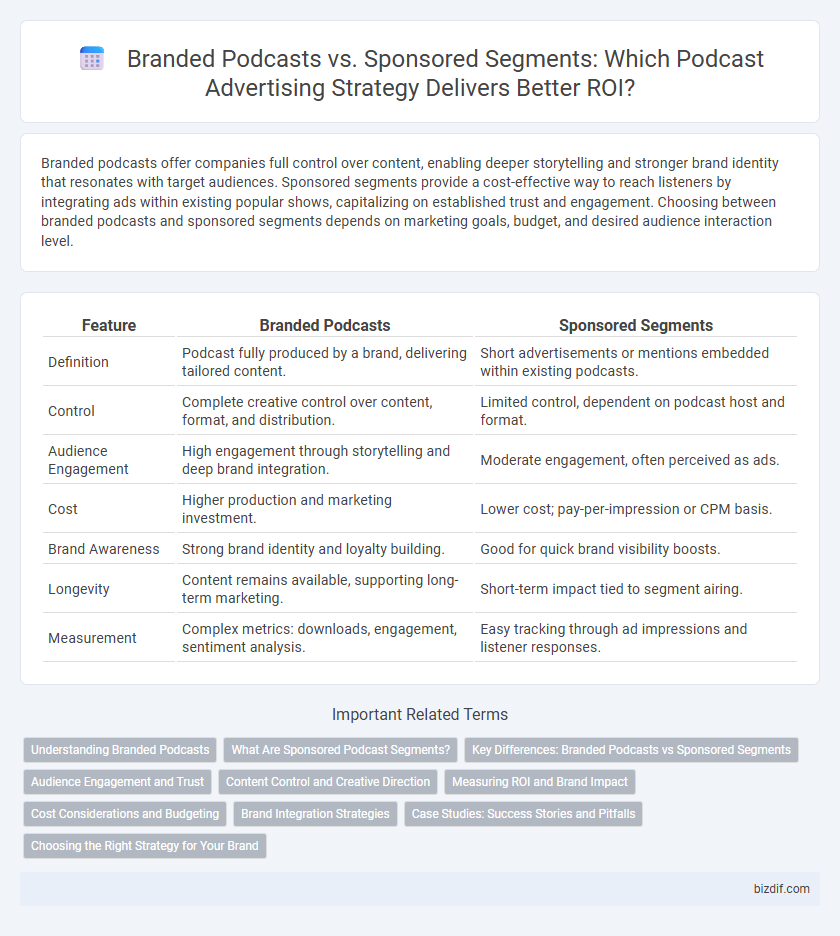Branded podcasts offer companies full control over content, enabling deeper storytelling and stronger brand identity that resonates with target audiences. Sponsored segments provide a cost-effective way to reach listeners by integrating ads within existing popular shows, capitalizing on established trust and engagement. Choosing between branded podcasts and sponsored segments depends on marketing goals, budget, and desired audience interaction level.
Table of Comparison
| Feature | Branded Podcasts | Sponsored Segments |
|---|---|---|
| Definition | Podcast fully produced by a brand, delivering tailored content. | Short advertisements or mentions embedded within existing podcasts. |
| Control | Complete creative control over content, format, and distribution. | Limited control, dependent on podcast host and format. |
| Audience Engagement | High engagement through storytelling and deep brand integration. | Moderate engagement, often perceived as ads. |
| Cost | Higher production and marketing investment. | Lower cost; pay-per-impression or CPM basis. |
| Brand Awareness | Strong brand identity and loyalty building. | Good for quick brand visibility boosts. |
| Longevity | Content remains available, supporting long-term marketing. | Short-term impact tied to segment airing. |
| Measurement | Complex metrics: downloads, engagement, sentiment analysis. | Easy tracking through ad impressions and listener responses. |
Understanding Branded Podcasts
Branded podcasts offer companies full control over content, allowing deeper storytelling and stronger audience engagement compared to sponsored segments that serve as brief ads within existing shows. These podcasts build brand loyalty by delivering valuable, relevant content aligned with the brand's voice and mission, fostering long-term relationships. Investment in branded podcasts supports sustained visibility and richer customer insights through direct listener feedback and analytics.
What Are Sponsored Podcast Segments?
Sponsored podcast segments are concise promotional messages integrated within episodes, typically lasting 15 to 60 seconds, designed to advertise a brand without disrupting the listener's experience. These segments often involve hosts delivering personalized endorsements, enhancing authenticity and listener trust compared to traditional ads. They enable brands to reach targeted audiences through podcast content aligned with their values, maximizing engagement and ROI.
Key Differences: Branded Podcasts vs Sponsored Segments
Branded podcasts are full-length audio series created and controlled by a company to build brand identity and engage directly with their target audience, offering deep storytelling and consistent messaging. Sponsored segments appear within third-party podcasts as short advertisements or promotions, providing brand exposure without content control or narrative integration. The key differences lie in ownership, creative control, content depth, and audience engagement, with branded podcasts allowing for long-term brand building and sponsored segments focusing on immediate reach and visibility.
Audience Engagement and Trust
Branded podcasts foster deeper audience engagement by delivering consistent, value-driven content that aligns closely with the brand's identity, enhancing listener loyalty and trust. Sponsored segments, while effective for quick exposure, risk interrupting the listener experience, potentially diluting trust if the messaging feels intrusive or mismatched with the podcast's tone. Employing branded podcasts allows brands to build authentic relationships over time, leveraging storytelling to strengthen credibility and drive sustained audience connection.
Content Control and Creative Direction
Branded podcasts offer full content control and creative direction to the brand, enabling tailored storytelling that aligns precisely with their values and audience interests. Sponsored segments typically provide limited influence, as brands must adapt to the podcast host's style and editorial choices, resulting in less cohesive messaging. The ability to shape the entire narrative in branded podcasts enhances audience engagement and brand authenticity more effectively than isolated sponsored placements.
Measuring ROI and Brand Impact
Measuring ROI and brand impact for branded podcasts involves analyzing listener engagement, download metrics, and brand recall over time, providing comprehensive insights into long-term audience loyalty. Sponsored segments offer more immediate tracking through click-through rates, promo code usage, and direct sales attribution, enabling sharper measurement of short-term campaign effectiveness. Both approaches require tailored analytics to evaluate contribution to brand awareness and revenue growth within podcast marketing strategies.
Cost Considerations and Budgeting
Branded podcasts require a higher upfront investment for content creation, production, and distribution but offer full control over messaging and long-term brand building. Sponsored segments typically involve lower costs, often negotiated as part of existing podcast ad inventory, providing more flexibility for limited budgets. Allocating budget depends on goals: branded podcasts favor sustained engagement and brand equity, while sponsored segments deliver targeted exposure with immediate ROI.
Brand Integration Strategies
Branded podcasts offer immersive brand integration by delivering tailored content that deeply aligns with the brand's identity and values, fostering stronger listener engagement and loyalty. Sponsored segments provide flexible placement within established shows, enabling targeted exposure without disrupting the audience's experience or the podcast's narrative flow. Effective brand integration strategies leverage storytelling and native advertising to seamlessly embed brand messages, maximizing recall and emotional connection.
Case Studies: Success Stories and Pitfalls
Branded podcasts offer companies full creative control, demonstrated by HubSpot's "The Growth Show," which boosted brand loyalty by delivering tailored content that resonates deeply with target audiences. Sponsored segments, exemplified by Mailchimp's collaborations on popular shows like "Serial," provide exposure within established listener bases but risk diluted messaging if the integration feels inauthentic. Case studies reveal that branded podcasts excel in long-term audience engagement, while sponsored segments succeed in short-term brand awareness, emphasizing the need to align strategy with marketing goals to avoid common pitfalls such as low listener retention or misaligned audience targeting.
Choosing the Right Strategy for Your Brand
Branded podcasts create immersive storytelling experiences tailored to a specific brand, fostering deeper audience engagement and long-term loyalty. Sponsored segments offer targeted exposure within popular podcasts, delivering immediate reach and brand awareness to niche audiences. Assessing your brand goals, budget, and desired level of control helps determine whether a fully branded podcast or sponsored placement drives more effective marketing outcomes.
Branded podcasts vs Sponsored segments Infographic

 bizdif.com
bizdif.com